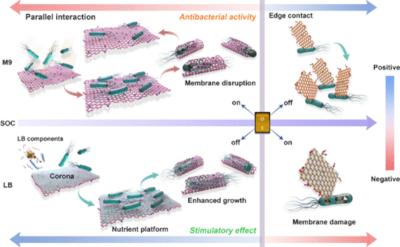The amount of surface oxygen in graphene materials is a key factor in how effective they could be in killing bacteria – a discovery which may help to design safer and more effective products to combat antimicrobial resistance.
Researchers from the UK's University of Birmingham, China's Shandong University of Technology, Chinese Academy of Sciences and National Center for Nanoscience and Technology of China, NovaMechanics in Cyprus, Austria's Medical University of Innsbruck, University of Eastern Finland and Leiden University in the Netherlands have found that it is graphene oxide’s different interaction modes that lead to distinct antibacterial activity – with a ‘switch’ occurring when surface oxygen levels reach a certain threshold.
Graphene oxide with high surface oxygen content (SOC) is very flexible and can wrap around bacteria (a parallel mode of contact), but when it has lower SOC the material has higher rigidity and tends to contact bacteria edgewise (in a perpendicular mode).
Neither mode necessarily kills bacteria, but bactericidal activity depends on how the material interacts with surrounding biomolecules. The discovery will help scientists to understand the different possible physical mechanisms leading to their antibacterial activity.
A slight change of SOC can lead to the shift of interaction modes between parallel and perpendicular contact. “The impact of SOC on the interaction mode has been underestimated for a long time”, commented Dr Zhiling Guo, from the University of Birmingham.
Dr. Peng Zhang from the University of Birmingham commented: “Our research highlights that surface oxygen levels can help to evaluate the antibacterial effects of graphene materials - helping to design safer materials through clarifying the role of SOC.”
As antimicrobials, graphene materials may have advantages over traditional antibiotics due to their physical mechanisms of action which ensure less chance of development of microbial resistance.
Until now, the fundamental question as to whether the antibacterial mechanism of graphene materials originates from parallel interaction or perpendicular interaction, or from a combination of these, remains poorly understood - hindering progress in developing antibacterial graphene materials and understanding their environmental safety.
Professor Iseult Lynch, from the UnIversity of Birmingham, noted that “The discovery is a potential ‘gamechanger’ and we should be using this surface oxygen ‘switch’ as the determining property to define and classify graphene materials in the context of human health and environmental safety.”
The international research team created a series of graphene materials with different SOCs and compared their antibacterial performance - evaluating total cell growth, biofilm formation and oxidative stress, as well as physical interactions with bacteria including through molecular simulations.
Different interaction modes lead to distinct antibacterial activity and interaction mode is highly related to the rigidity of the graphene materials which depends on the amount of surface oxygen.


